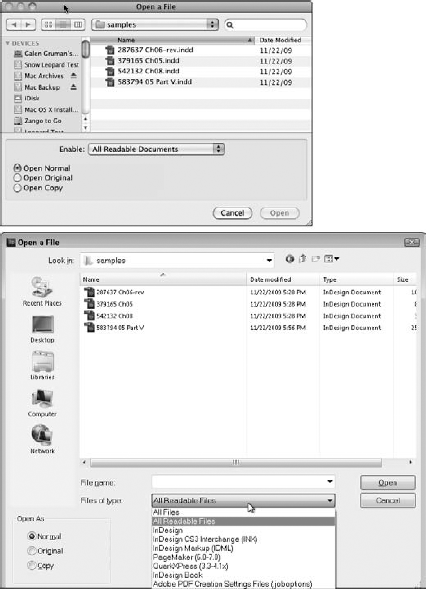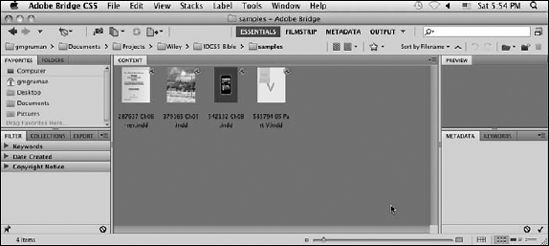Opening documents with InDesign is pretty much the same as opening documents with any program. Simply choose File => Open
or Ctrl+O, locate and click the document you want to work on, and then
click Open. But InDesign offers a few options for opening documents you
don't find in every program. For example, you can:
Open more than one document at a time.
Open
a copy of a document instead of the original. This keeps you from
overwriting the original file accidentally — very helpful if you're
making several variations of one document.
Open interchange
document versions of InDesign files. The InDesign Markup (IDML) format,
for example, lets both InDesign CS4 and CS5 open files exported from
InDesign CS5, and the InDesign Interchange (INX) format lets InDesign
CS3, CS4, and CS5 open files exported from InDesign CS3 and CS4. (Note
that InDesign CS5 cannot export INX files. The IDML format can also be
created and opened by other programs, such as custom publishing
databases, so unlike the INX format, it's not just as a way to downsave files for use by earlier versions of InDesign.)
Open
a template under its own name. This makes editing templates easier than
it is with other programs, specifically QuarkXPress.
Open
documents created with some versions of PageMaker and QuarkXPress:
QuarkXPress and QuarkXPress Passport versions 3.3 through 4.1 and
PageMaker versions 6.0 through 7.0.
|
InDesign's File menu displays the names of the ten
most recently saved documents in the Open Recent submenu that appears
under the Open option in the File menu after you have opened a file. You
can change how many recently saved files are shown by using the Number
of Recent Items to Display option in the File Handling pane of the
Preferences dialog box (choose InDesign => Preferences => File Handling or choose Edit => Preferences => File Handling or press Ctrl+K in Windows).
|
|
To open a file:
Choose File => Open or Ctrl+O. The Open a File dialog box shown in Figure 1 appears.
Locate and open the folder that contains the documents you want to open. Click a file name or Ctrl and click multiple file names.
In
Windows, the Files of Type pop-up menu offers several options: All
Files, All Readable Files, InDesign files, IDML, InDesign CS3
Interchange (INX), PageMaker 6.0–7.0 files, QuarkXPress 3.3–4.1x files,
Adobe PDF Creation Settings Files, InDesign Book, and All Formats.
Choose any of these options to display a specific file format in the
file list. (Choose All Files in the Files of Type pop-up menu to display
files with no extensions.)
Note that InDesign CS5
can open files created by any previous version of InDesign, in addition
to CS5-created files. The InDesign Markup (IDML) format is a variation
of the standard InDesign CS5 format that lets InDesign CS4 read your CS5
files, minus any CS5-specific formatting. (It can also be used with
some other specialized programs.) Also note that there is no save or
export option that lets InDesign CS3 or earlier open files created in
InDesign CS5.
On a Mac, the Open a File dialog box
displays any supported file formats that have file name extensions, and
the dialog box includes a Preview pane that displays a thumbnail
version of the selected file or, more commonly, its icon. (Choose All
Documents in the Enable pop-up menu to display files without the file
name extensions.)
NOTE
The name of the pop-up menu for selecting file
types differs between the Mac and Windows versions of InDesign, as does
the menu option for displaying all files (including those with no file
name extensions).
Click
Open Normal (Mac) or Normal (Windows) at the bottom of the Open a
Filedialog box if you want to open the original document (rather than a
copy of the document); click Open Copy (Mac) or Copy (Windows) to open a
copy of a document(see Figure 1). When you open a copy of a document, it's assigned a default name(Untitled-1, Untitled-2, and so on).
If
you want to use a template to create a new version of a publication,
select Normal; InDesign creates a document based on the template. To
open a template under its own name so that you can edit it, click Open
Original (Mac) or Original (Windows). Templates are explained in the
following section. (For documents, selecting Open Normal/Normal or Open
Original/Original does the same thing: It opens the document for
editing.)

|
Both Windows and Mac OS X use icons to show you (and
tell programs) the format of a file. They also use file name extensions
to identify the file type, but by default these file name extensions are
hidden from view when you open folders.
InDesign uses the file name extension .indd
to denote InDesign documents. Without this file name extension, you
won't be able to double-click a file icon to open it, although you can
still open the file from InDesign's Open a File dialog box (choose File => Open or Ctrl+O), as long as you select All Documents from the Enable pop-up
menu (on the Mac) or All Files from the Files of Type pop-up menu (in
Windows). Note that the Place dialog box for importing text and graphics
— does not have the Enable pop-up menu on the Mac; InDesign shows all files, even unsupported ones, in this dialog box.
If file name extensions are hidden in Windows XP, open any folder, choose Tools =>
Folder Options, and then select the View tab. (You have to have a disk
or folder open to have the View menu.) Select the Show Hidden Files and
Folders option and then click OK.
In Windows Vista, choose Start => Computer, choose Organize =>
Folder, and then choose Search Options in the dialog box that appears.
Go to the View pane and select the Show Hidden Files and Folders option,
then click OK.
In Windows 7, the steps are the same as for Vista,
except you choose Folder and Search Options (Windows 7's name for
Vista's Search Options).
If file name extensions are hidden in Mac OS X 10.5 Leopard or Mac OS X 10.6 Snow Leopard, choose Finder =>
Preferences, go to the Advanced pane, select the Show All File
Extensions option, and close the dialog box. (You have to be using the
Finder, not be in an application, to get this menu.)
|
Click OK to close the dialog box.
Each document you open appears in a separate document window. The page
and view magnification shown when a document was last saved is used when
you open the document.
|
You can also open an InDesign document or template by
double-clicking its file icon. If InDesign is not running,
double-clicking a document or template file — as long as it has the
proper file name extension (.indd for documents and .indt
for templates) — launches the application and opens the
document/template. If InDesign is already running, the document appears
in a new window.
|
|
1. OPENING documents versus opening templates
Whenever you save a document, you have the option of
saving a standard document file or a template . A template is
an InDesign file used to create multiple iterations of the same
publication. For example, if you produce a monthly newsletter, you can
save gobs of time and ensure consistency from issue to issue by using a
template asR the starting point for each edition of the newsletter. A
template is essentially the shell of a publication that contains the
basic framework — page layout, master pages, styles, and so on — but
doesn't contain any actual content.
When you open a template, you have two choices: You
can open a copy of the file and use it to create a new publication or
you can open the original file, make changes, and then save an updated
version of the template.
If you want to use a template as the starting point for a new publication, choose File => Open
or Ctrl+O, locate and select the template, and make sure Open Normal
(Mac) or Normal (Windows) is selected in the Open a File dialog box
(refer to Figure 1) before you click Open.
If you want to modify a template, click Open Original
(Mac) or Open (Windows) at the bottom of the dialog box. If Open Normal
(Mac) or Normal (Windows) is selected, clicking Open opens a new
document window and assigns the document a default name: Untitled-1,
Untitled-2, and so on. If Open Original (Mac) or Original (Windows) is
selected, the original file opens and the original name appears in the
title bar.
2. Working with files in the Bridge file system
There's another way to open documents and templates in InDesign: Choose File => Browse in Bridge or Ctrl+Alt+O to open documents or templates, or choose File => New => Document from Template to open just templates. Choosing either option opens the Adobe Bridge program, shown in Figure 2, where you can browse for a file to open.

Bridge is designed to be a central repository for
Creative Suite programs and support files, mainly for use in workgroup
situations but also as an Adobe-centric alterative to the standard Mac
and Windows file systems. Bridge's biggest attraction is that it lets
you see previews of and file information for almost all the files types
you'd be working with in your layouts (and Bridge does come with several
canned templates created by Adobe that you might want to consider
using).
There's no difference in the documents or templates
available via Bridge than those available via the regular Open a File
dialog box. It's just a different organizational structure for your
files.
If you want to access the template files stored in Bridge's InDesign folder without using Bridge itself, navigate to Library:Application Support:Adobe:Templates:InDesign on the Mac, or to Program Files/Common Files/Adobe/Templates/InDesign
in Windows. Of course, if you do prefer to use Bridge to store template
files, you use InDesign's regular Save As dialog box, select InDesign
CS5 Template as the file format, and navigate to the Bridge
application's InDesign folder.
You can access Bridge files directly from the Bridge application, using its folder-based interface to find files of interest.
NOTE
Most of Bridge's features are oriented to Photoshop users, so chances are you can just ignore Bridge.
NOTE
The new Mini Bridge panel (choose Window =>
Mini Bridge) is a faster way to find files using Bridge's file
environment. Click the Search iconic button to search for specific
files, or click the Browse Files iconic button to navigate for files
using a pared-down version of the Adobe Bridge file-navigation controls.